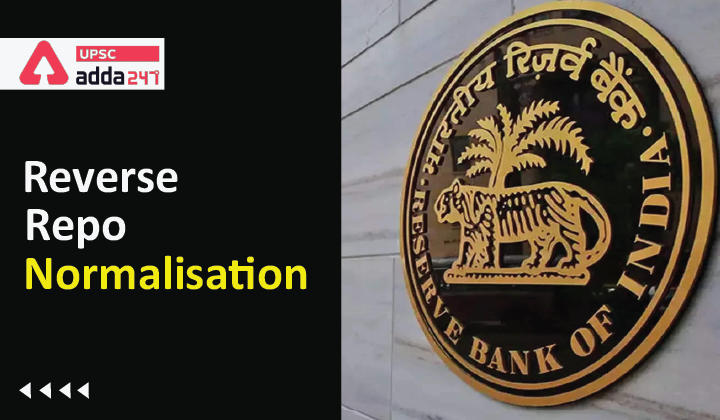Table of Contents
Reverse Repo Normalisation: Relevance
- GS 3: Indian Economy and issues relating to planning, mobilization, of resources, growth, development and employment.
Reverse Repo Normalisation: Context
- Recently, State Bank of India has stated that it believes the stage is set for a reverse repo normalisation.
What is reverse repo normalisation?
- Before understanding reverse repo normalisation, let us first know what is reverse repo and how it is not normal in present scenario.
Monetary policy normalisation
- Reserve Bank of India makes certain changes in the total amount of money in the economy so that Indian economy functions smoothly.
- When the RBI wants to boost economic activity, it adopts a “loose monetary policy”. There are two parts of this policy:
- One, the RBI injects more money into the economy and thus increases the liquidity by buying government bonds from the market.
- Two, the RBI also lowers the repo rate, and hopes that the commercial banks, in turn, will feel incentivised to lower interest rates.
- Lower interest rates and more liquidity are expected to boost both consumption and production in the economy.
- The opposite of a loose monetary policy is a “tight monetary policy”. It involves the RBI raising interest rates and sucking liquidity out of the economy by selling bonds (and taking money out of the system).
- When RBI finds that a loose monetary policy has started becoming counterproductive (like, when it leads to a higher inflation rate), the central bank “normalises the policy” by tightening the monetary policy stance.
What is reverse repo rate?
- The reverse repo is the interest rate that the RBI pays to the commercial banks when they park their excess liquidity with the RBI.
- The reverse repo, thus, is the exact opposite of the repo rate.
Benchmark for interest rate
When the economy is growing
- Repo rate is the benchmark interest rate.
When the economy is decelerating
- Businesses stop making fresh investments and, as such, do not ask for as many new loans.
- It means the banks’ demand for fresh funds from the RBI also gets diminished.
- In this case, banking system have sufficient liquidity, but they are not lending to businesses, due to two reasons:
- One, because banks are too risk-averse to lend; and
- Two, because the overall demand from the businesses has also come down.
- In these situations, the action shifts from repo rate to reverse repo rate because banks are no longer interested in borrowing money from the RBI.
- Rather, banks are more interested in parking their excess liquidity with the RBI. And that is how the reverse repo becomes the actual benchmark interest rate in the economy.
- Indian economy faced this situation during COVID-induced lockdown.
- RBI, during lockdown, had widened the gap between repo rate and reverse repo rate in order to make it less attractive for banks to simply park their funds at the RBI.
Reverse repo normalisation
- Simply, it means the reverse repo rates will go up.
- Due to rising inflation, several central banks around the world have increased the interest rate. In India, RBI too is expected to raise the repo rate. However, before increasing repo rate, it will first raise the reverse repo rate to reduce the gap between the two rates.
- SBI first expects the reverse repo to go up from 3.35% to 3.75% while the repo rate continues to be 4%. It will incentivise commercial banks to park excess funds with RBI, thus sucking some liquidity out of the system.
Why is normalisation needed?
- This process of normalisation is aimed at curbing inflation.
- It will not only reduce excess liquidity but also result in higher interest rates across the board in the Indian economy.
- It will thus reduce the demand for money among consumers as they would prefer to just keep the money in the bank.
- Thus, it will make it costlier for businesses to borrow fresh loans.



 TSPSC Group 1 Question Paper 2024, Downl...
TSPSC Group 1 Question Paper 2024, Downl...
 TSPSC Group 1 Answer key 2024 Out, Downl...
TSPSC Group 1 Answer key 2024 Out, Downl...
 UPSC Prelims 2024 Question Paper, Downlo...
UPSC Prelims 2024 Question Paper, Downlo...
